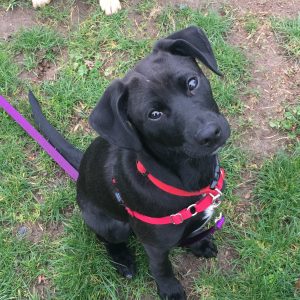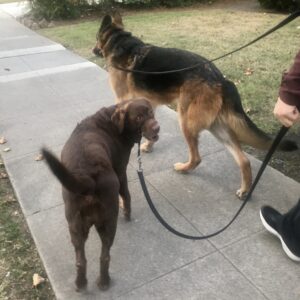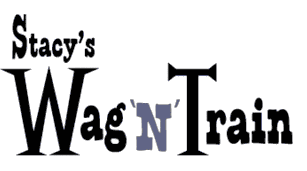Get your dog to focus on YOU!
© Stacy Braslau-Schneck, CPDT

Does your dog lose all focus on you in a training class? Does she forget you exist when you go to the dog park? Is she more interested in meeting other dogs or other people than in paying attention to you? Spend a few minutes each day for a week to build a solid foundation of attention.
If you take the time to do these exercises you will greatly improve your dog’s ability to focus on you and respond to your commands in a class situation or other distractions, including being around other dogs.
Day One
Pick a marker word to use as a clicker. The marker will mark the moment the dog achieves the goal you’ve set, and promises the dog a great reward. You can of course use a clicker but you will be doing a lot of opportunistic training, and it will be helpful to have a word or sound like “Yes!” or “Good!” to have handy. Remember, the marker is not in itself praise (you’ll want to praise your dog, too!), but it is the sound of payoff to your dog.
Charge up your marker by saying it and immediately after giving the dog a treat. Make sure that the marker comes first, and then the treat.
Find a non-distracting environment – your home kitchen or living room (not the dog park or class room!). Watch your dog’s eyes. Whenever your dog looks at you, click or say your marker word, and give your dog a treat. Don’t do anything special to get your dog’s attention – just wait for it and capture it. Do this throughout the day.
In addition to noticing your dog’s attention to you throughout the day, do some rapid rounds of rewarding eye contact. For one minute, click or mark and treat every time your dog looks at you – as many times as you possibly can in one minute. Repeat this a few times.
Now play “The Eye Contact Game”: hold some treats in your hand and hold your hand out to one side. Try to find the sweet spot where the treats are close enough to the dog to be distracting, but not so close that your dog is desperately trying to get them, and frustrated when she can’t. Don’t say anything to get your dog’s attention; just wait patiently while your dog stares at the treats. The moment the dog tears her eyes off of the hand with the treats and looks at your face instead, click and treat!
Alternatively, you can play find it/find me or “the up and down game”, by placing one treat or piece of kibble at your dog’s feet, allowing him to eat it, and marking the moment the dog looks back up at you. Reward that look by placing another treat at your dog’s feet, so that you soon get a smooth cycle of the dog looks up, the treat goes down, the dog eats the treat and looks up, and the next piece of food goes down. (For more pattern games like this, see Control Unleashed: Reactive to Relaxed, by Leslie McDevitt.)
By the end of this day, you should have marked and rewarded your dog for looking at you fifty times or more!
Day Two
If you can predict that your dog will look at you, say your dog’s name first. When she looks at you, click or mark and treat. If you guessed wrong, and your dog didn’t look at you after you’ve said her name, you’ve set yourself back a tiny step. Don’t assume that the dog understands the relatively sophisticated concept of an individual’s name. You will be teaching the dog that hearing her name is an opportunity to get a reward if she chooses the right action – looking at you. If she didn’t look at you when you called her name, immediately go back to rewarding her for looking at you, as many times as you can, in a minute. Now you can probably be better at predicting when the next eye contact will come – say the dog’s name first.
Continue to notice any time your dog looks at you during the day. Mark and reward each time. Try to have 100 successful sequences of “Dog’s Name” + look at you + mark & treat.
Day Three
Go near a place that is interesting and potential distracting for your dog – a dog park, a pet store. Do NOT go in yet! Move away from where the interesting action is – far enough that the dog is no longer entirely focused on the action. Find the “sweet spot” location that is far enough away that your dog can look away from the distractions, but close enough that your dog is aware of the distractions. Stop at that distance away – up to a block away – and wait. Wait for your dog to look at you. When she does, mark it, treat it, and celebrate! Is she still looking at you? Mark and treat it again. Do your one-minute round of rewarding eye-contact. If it’s predictable, put the dog’s name on it.
Why are you waiting and not trying to get the dog’s attention? Because you want the dog to be able to look at you on her own, without you having to do all the work up front. Patience will pay off!
For safety’s sake, and for control, your dog should be on leash. But your goal is to get the dog to look at you even when there is no leash, so try not to use the leash to get her attention. You want the cue to look at you to be her name, not a tug on her collar. If you have a hard time handling leash, clicker, and treats, or keeping your hands from tugging, drop the leash to the ground and step on the handle.
Throughout the day, make sure that you mark and reward each time your dog looks at you.
Day Four

Go back to your exciting place and go to the distance you were successful at before. Do one minute of rewarding attention. Are you rewarding as many sequences of the dog looking at you and you clicking and treating as you could at home, with fewer distractions around? If so, move a few feet closer to the interesting action, and do another minute of rewards. When you can predict that the dog will look at you, say her name just before she does.
Every time you say the dog’s name and she looks at you and you reward her, you’re making headway, moving forward towards your goal, gaining points for your team! Every time you guess wrong and say the dog’s name but she doesn’t look at you, you’re losing ground, losing points.
Dogs don’t learn commands the way we do. Studies show that dogs need to hear a command paired with the action that is rewarded 30-40 times before they make a strong association between the command (cue) and the action that will get them the reward.
If another dog or other distracting thing comes too close to you for your dog to ignore, either wait until it’s past again and the dog turns her attention back to you, or move a few feet away, backwards. In addition to these exercises, be sure to mark and reward your dog for looking at you at any time during the day.
Day Five
Go back to a distracting place again, do a one-minute round of rewarding attention at the place you were successful at before, and continue moving closer a few feet. Again, add the dog’s name if you can, and move calmly away from distractions if they get too overwhelming.
Continue to mark and reward your dog for looking at you at any time during the day.
Day Six
Reward your dog for paying attention to you at a distance from the distractions. Move a little closer, allow your dog to notice the distraction, and immediately call her name and move backwards excitedly. As soon as she turns towards you, click and treat. Reward her several more times for looking at you at that distance from the distraction.
Praise her, and start to move back towards the distraction. Allow her to notice the distraction and again call her to you while moving backwards. Repeat this as many times as you can in five minutes. Please note that you should not use someone else calling her name as a distraction (your dog should always come when she’s called, and that response should pay off for her. You don’t want her to learn to ignore that call)!
Day Seven
Go to your distracting place. Charge up her attention by rewarding it at a distance from the distractions. Move closer to the distractions, allow her to become interested in them for a moment, then call her name and move backwards away from the distractions.
You’ve now spent a few minutes each day building up a history of rewarding your dog for looking at you, even around some attractive distractions. If you’ve managed to mark and reward your dog’s attention 50 times or more each day, you’ll be nearing 400 successes already! This is the foundation for good attention. You may need to continue this training. Be sure that you continue to reward your dog for paying attention to you in the situations where it’s important to you – such as in class, at the dog park, while walking through crowds, etc.
Links
Helix Fairweather’s description of the Eye
Eye Contact Game; Dani Weinberg’s description.
All material copyright Stacy Braslau-Schneck. Reprints for non-commercial use, and with the author’s permission only.
Would you, your training company, or your club like to reprint this? Please be sure to keep my name, business name, and the website URL with the article, and if possible, please send me a copy. See the Contact Page for email and mailing address.

